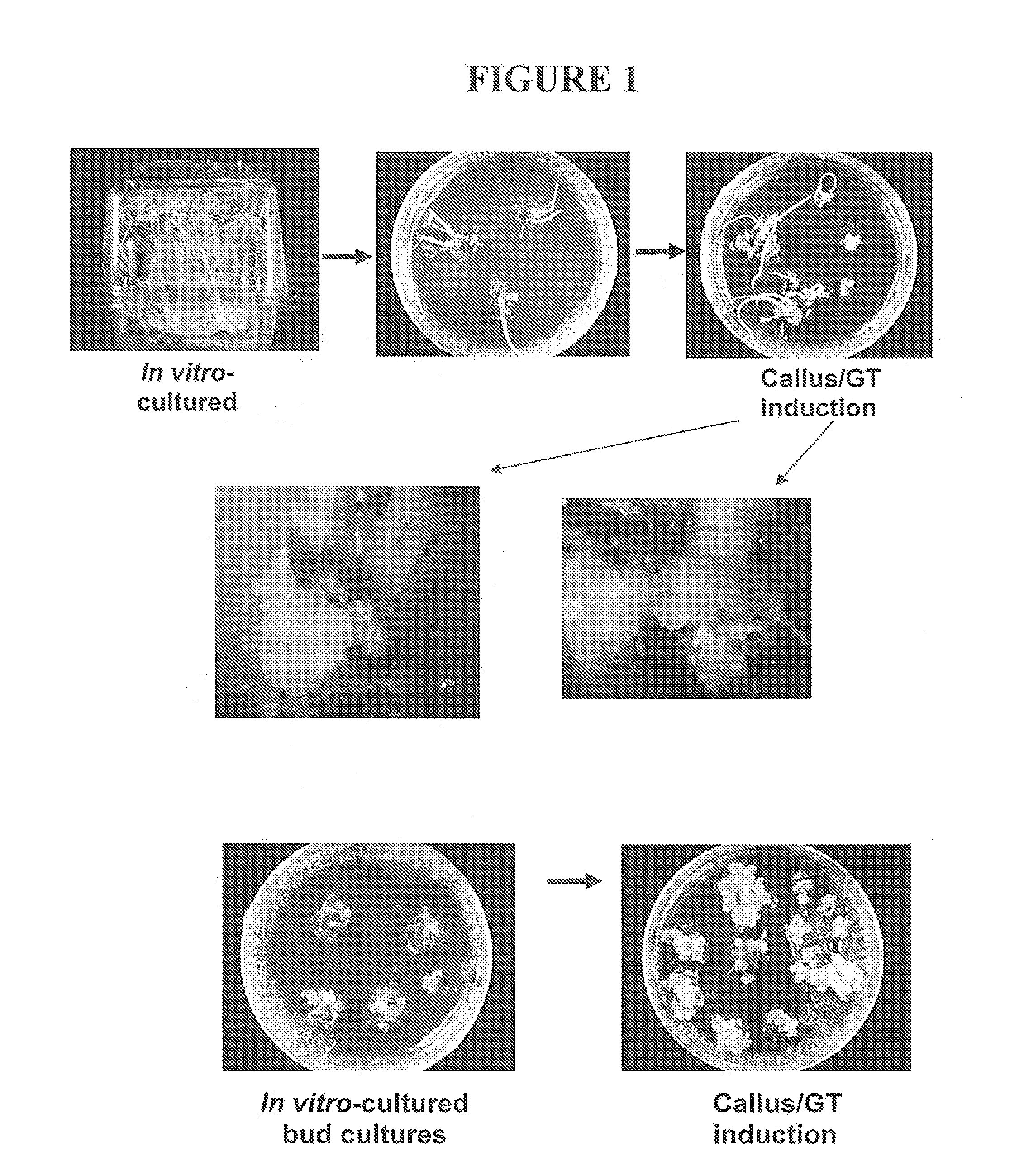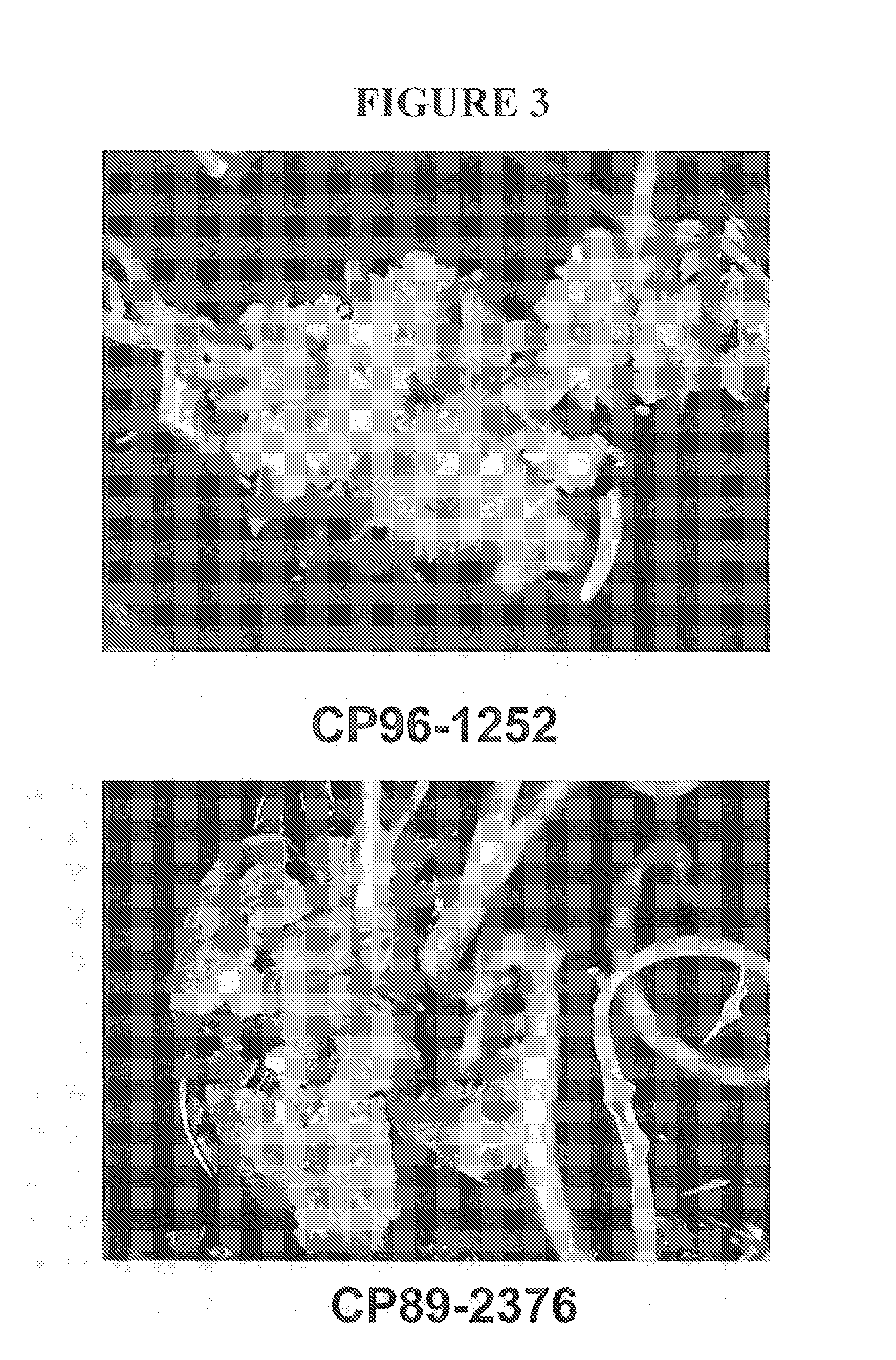Methods for tissue culture and transformation of sugarcane
a tissue culture and sugarcane technology, applied in the field of plant biotechnology, can solve the problems of limited conventional plant breeding methods, subsequent phenotypic abnormalities, performance loss, etc., and achieve the effects of less somaclonal variation, efficient regeneration of monocotyledonous plants, and long-term regeneration
- Summary
- Abstract
- Description
- Claims
- Application Information
AI Technical Summary
Benefits of technology
Problems solved by technology
Method used
Image
Examples
example 1
Tissue Culture System for Callus and Green Regenerative Tissue Induction
[0164]Callus and green regenerative tissues were the target explants for transformation. The target tissues can be derived from in vitro-cultured whole plantlets, in vitro cultured buds, and immature whorls. Plantlets (about 6-8 plantlets) were in sugarcane maintenance media MSA in Phytatrays (FIG. 1) or Magenta boxes. MSA+100 mg / L carbenicillin can be used to control contamination of endogenous bacteria if the source material is not completely sterile. In vitro-cultured buds were obtained from cultivars CP96-1252, CP01-1372, CP89-2376, and CPCL97-2730. Approximately 1-3 plantlets or in vitro cultured buds with approximately 3-5 tillers / buds were separated as necessary, making sure to preserve the leaf base and meristem regions. Plantlets and bud pieces (about 3-6 pieces per plate) were transferred in a tissue induction medium. Nine different tissue induction media were tested for the ability of each sugarcane c...
example 2
Sugarcane Agrobacterium Transformation Using Sugarcane Callus and Green Regenerative Tissues
Media for Plant Transformation:
[0177]Liquid DBC3(M5G) contains MS salts (4.3 g / L) plus maltose (30 g / L); glucose (5 g / L); thiamine-HC1 (1 mg / mL); myo-inositol (0.25 g / L); N—Z-amine-A (casein hydrolysate) (1 g / L); proline (0.69 g / L); CuSO4 (4.9 μM); 2,4-D (1.0 mg / L); BAP (0.5 mg / L); Adjust volume to 1 L with ddH2O; pH 5.8—Adjust pH with 1 M KOH; autoclave.
[0178]DBC3 contains MS salts (4.3 g / L) plus maltose (30 g / L); thiamine-HC1 (1 mg / mL); myo-inositol (0.25 g / L); N—Z-amine-A (casein hydrolysate) (1 g / L); proline (0.69 g / L); CuSO4 (4.9 μM); 2,4-D (1.0 mg / L); BAP (0.5 mg / L); Adjust volume to 1 L with ddH2O; pH 5.8—Adjust pH with 1 M KOH; Phytagel (3.5 g / L); autoclave.
[0179]DBC6 contains MS salts (4.3 g / L) plus maltose (30 g / L); thiamine-HC1 (1 mg / mL); myo-inositol (0.25 g / L); N—Z-amine-A (casein hydrolysate) (1 g / L); proline (0.69 g / L); CuSO4 (4.9 μM); 2,4-D (0.5 mg / L); BAP (2.0 mg / L); Adjust v...
example 3
Agrobacterium Strain Comparison for Sugarcane Transformation
[0185]Two Agrobacterium strains, AGL1 and LBA4404, were compared for transformation frequency in CP89-2376 and CP01-1372. Callus tissues of both cultivars were induced and maintained on DBC3 medium. Tissues were infected with Agrobacterium containing pDsREDmoPAT in liquid 10 mM MgSO4 plus 100 μM acetosyringone and broken / chopped into small pieces. The tissues were then co-cultivated with liquid DBC3 (M5G) medium plus 100 μM acetosyringone on the filter paper at 21° C. in the dark. Three days after co-cultivation, the tissues were transferred to DBC3+100 mg / L cefotaxime+150 mg / L timentin for AGL1 and DBC3+100 mg / L carbenicillin for LBA4404, and incubated at 26° C. (±1° C.) in the dark or dim light for 3-7 days. The tissues were then transferred to the same media as the previous step plus 3 or 5 mg / L bialaphos. After 2 to 3 weeks, the tissues were transferred to 2nd round selection DBC6 containing antibiotics and 3-5 mg / L bia...
PUM
| Property | Measurement | Unit |
|---|---|---|
| Molar density | aaaaa | aaaaa |
| Molar density | aaaaa | aaaaa |
| Density | aaaaa | aaaaa |
Abstract
Description
Claims
Application Information
 Login to View More
Login to View More - R&D
- Intellectual Property
- Life Sciences
- Materials
- Tech Scout
- Unparalleled Data Quality
- Higher Quality Content
- 60% Fewer Hallucinations
Browse by: Latest US Patents, China's latest patents, Technical Efficacy Thesaurus, Application Domain, Technology Topic, Popular Technical Reports.
© 2025 PatSnap. All rights reserved.Legal|Privacy policy|Modern Slavery Act Transparency Statement|Sitemap|About US| Contact US: help@patsnap.com



